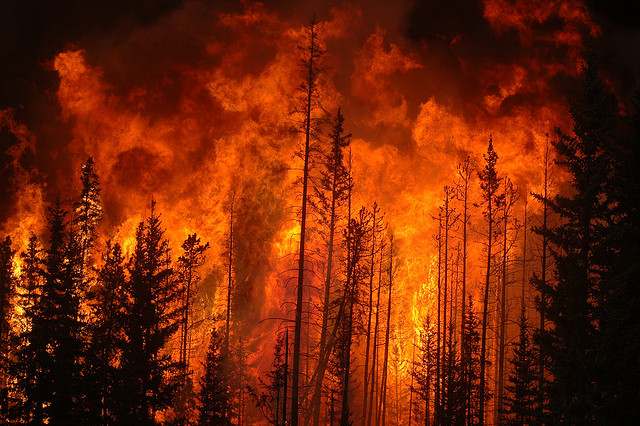Chip in to keep stories like these coming.
Saskatchewan’s summer has been a snapshot of our climate future. Massive wildfires exploded across the north of the province, forcing the evacuation of over 13,000 people — dubbed by some as Saskatchewan’s first “climate change refugees.” Smoke from the fires was so intense it caused air quality warnings in Saskatoon and Regina, choking residents with smoke as far south as Minnesota. The fires were stoked by intense heat and drought across the prairies. In Saskatchewan, the persistent drought has seen river levels drop to dangerous lows, while the province is set to record its worst harvest in years. Hydrologists warn that such drought may be the new normal, as run-off from the snow-pack in the Rockies diminishes to a trickle due to the effects of climate change. Despite the ferocity of these events, Saskatchewan’s Premier has been loathe to connect them with climate change, insisting that these events are discrete, one-off events rather than the start of a “new normal.”
Perhaps we should not be surprised by the Premier’s failure to connect-the-dots, given his long record of downplaying Canada’s contribution to climate change, his disdain for hard emission targets and his unrepentant boosterism for oil, gas and coal. With Saskatchewan’s annual per capita greenhouse gas emissions well over three times the Canadian average and almost 10 times higher than the world average, it is urgent that we begin to take responsibility for our own contribution to climate change. In order to do this, we will need strong leadership at the federal level. Saskatchewan is highly dependent on coal for electricity generation — half of Saskatchewan’s electricity comes from coal-fired plants which make up the bulk of that sector’s GHG emissions. Rather than transition away from coal and try and match renewable energy leaders like Iowa and South Dakota who currently generate 28.5 per cent and 25.3 per cent of their power from wind respectively, Saskatchewan has hitched its wagon to the promise of “clean coal.”
The provincial and federal government has sunk close to $1.5 billion into SaskPower’s Carbon Capture project which will capture carbon from one coal-fired plant and then sell the carbon to assist in the extraction of unconventional oil deposits. As Mark Bigland-Pritchard and Brian Banks outline in their study of the project, the one million tonnes of CO2 captured amounts to only about seven per cent of all GHG’s created by SaskPower’s coal-fired generation, and less than two per cent of the province’s total emissions. Moreover, for each tonne of carbon dioxide used to recover oil, about 2.7 tonnes of carbon dioxide are eventually emitted from combustion of the extra oil recovered. As a climate change strategy, CCS is a bust. However, the absence of federal leadership and the lack of a national climate change strategy has led to a patchwork of different provincial policies, each addressing climate change in its own way — with some more effective than others.
Provinces like Saskatchewan that are particularly dependent on cheap fossil fuels for power generation and revenue will require federal leadership and financial incentives to make the transition to renewable energies more politically and economically attractive. Saskatchewan is actually well positioned to take advantage of the transition to renewable energy technologies. With the best solar profile in the country and some of the highest on-shore wind speeds, the province could be a renewable energy leader. What we need is a federal government that can put in place the right framework and incentives to make pursuing such a strategy politically and economically viable.
Ending subsidies to fossil fuels, a national price on carbon, improvements to the national electrical grid to facilitate hydro-sharing and a federal cost-sharing program for green energy are just some of the policies that could help move fossil-fuel dependent provinces like Saskatchewan into the green energy future. Sustainable Canada Dialogues — a group of over 60 scientists, engineers and economists — estimate that Canada has the potential to shift entirely to renewable sources of electricity by 2035 and eliminate 80 per cent of its greenhouse gas emissions by mid-century if we put the right federal policies in place. Indeed, as they conclude, the most significant barrier to achieving this shift is not technical or economic, but the absence of federal leadership and lack of political will.
If Canadians want to achieve the goal of a greener Canada, they have until October to determine which party has the requisite leadership and political mettle to move us forward.
Simon Enoch is Director of CCPA-Saskatchewan. Follow Simon on Twitter at @Simon_Enoch.
Photo: Cameron Strandberg/flickr
Chip in to keep stories like these coming.



